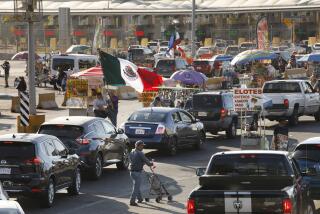UNAM Unfairly Gets Lion’s Share
- Share via
MEXICO CITY — When the federal police occupied the campus of the National Autonomous University of Mexico (UNAM) Feb. 6, ending a nine-and-a-half-month student strike, Mexico’s Finance Secretary Jose Angel Gurria rushed to publicly offer whatever government money was necessary to repair the damages left by the strikers. “The entire society,” he said, “is willing to help.”
But, it turned out that not everyone was happy with this quick offer of government financial aid. Alberto Cardenas, governor of the state of Jalisco, publicly complained that by giving additional federal money to UNAM--an institution that despite its name is largely based in Mexico City--the federal government was increasing the already glaring inequality among Mexican universities.
Cardenas, a member of the opposition National Action Party, said that UNAM already gets “three times as much money from the government than other universities in the country.” Giving it more money just because it was on strike would “send the message that the only way to get government money for universities is by striking.” The unequal distribution of federal spending between Mexico City--the country’s wealthiest city--and the rest of the country has been a source of resentment for a long time. But the inequality is particularly glaring in education.
In 1999, the federal government gave $3 billion in subsidies to the country’s universities. UNAM alone got $936 million, or 31% of the total. UNAM’s sheer size--260,000 students according to the Secretariat of Public Education, which makes it the biggest university in the Americas--doesn’t explain the entire subsidy. UNAM’s enrollment represents only 20% of the country’s university students.
Universities outside Mexico City got, on average, a government subsidy of $1,431 per student in 1999. UNAM received $4,158 per student. The Benito Juarez University, the top school of Oaxaca--one of the country’s poorest states--received only $642 per student in 1999.
The inequality doesn’t stop there. UNAM gets its entire subsidy from the federal government--that is, from taxpayers from all over the country. But universities outside Mexico City receive only 67% of their subsidy from the federal government. State administrations have to put up the rest.
Moreover, public university students outside of Mexico City are required to pay for at least a small portion of their tuition. Fees range from as low as $13 a year at the University of Guadalajara (although students are encouraged to make additional payments if they can afford it) to $100 a year at the University of Sinaloa (where students who can’t afford to pay are exempted). By contrast, at UNAM it was precisely the attempt to raise tuition fees from 2 cents to $100 a year for students who could afford to pay it that brought on the strike that paralyzed the school from April 20 of last year.
The inequality in educational spending isn’t limited to universities.
Mexican governors often complain that while their states have to dedicate considerable amounts of money to support education, schools in the capital of Mexico City are entirely supported by the federal government. “We spend 50% of our budget on education,” says Jalisco’s Gov. Cardenas. “The Federal District spends 0%.”
The centralization of Mexico’s political life, in spite of decades of lip service to federalism, is the main reason for this open inequality.
Federal politicians are concerned about student protests in Mexico City, the country’s central seat of power, but not in other areas of the country. This has generated a perverse relationship in which students in Mexico City get special privileges from the government because they protest more.
Student protests in Mexico City are usually organized or headed by leftist politicians. The leftist Democratic Revolution Party offered open support to UNAM strikers.
The National University administration is just starting to assess the damages of its recent strike. No one knows as yet what the final cost will be. But it is clear that if the government does approve a special budget extension to UNAM just because of the strike, it will continue to fall into the perverse game of politicizing Mexico’s universities.
More to Read
Sign up for Essential California
The most important California stories and recommendations in your inbox every morning.
You may occasionally receive promotional content from the Los Angeles Times.













